Sales compensation
Selling is getting more difficult — at least 61% of salespeople consider it much harder than 5 years ago. Decision-makers are less approachable, customers are less trustful, and their challenges are bigger. All these factors may easily undermine your sales reps’ motivation unless you set up your rewarding system and come up with smart sales compensation initiatives.
What is sales compensation?
Sales compensation refers to the payment a salesperson receives for their work, which commonly includes a base salary, commission, and additional monetary incentives to motivate a sales representative.
Things to consider:
Sales compensation should be well-planned to drive the sales team’s performance to success. This is why when speaking about sales compensation, one commonly means working out a clever sales compensation plan that would:
- Be aligned with sales roles. A sales compensation plan should be specific to the various roles and responsibilities of members within the sales team.
- Fit a company’s culture. A sales compensation plan should reflect your company’s unique set of assets. In particular, it’s necessary to understand how competitive your plan is in comparison to other businesses within your industry and how it is different for top and underperforming sales reps.
- Be clear and motivating. Your sales compensation plan should be simple enough to help your sales teams understand your company’s goals and the benefits they would get from it. Besides, it should presuppose rewarding them for the behaviors that result in business growth in general.

Sales compensation plan examples
There are many examples, or models, of a sales compensation plan. We will consider five models applied by companies worldwide:
1. Salary-based compensation plan model
The main advantage of this plan is that it makes it easy to calculate the compensation and predict hiring requirements. Besides, it relieves sales reps of stress associated with not meeting the goals.
Among its main disadvantages is the fact that without commission, sales teams may not be motivated enough to close many deals. As a result, a company risks losing its top-performing salespeople who will be interested in receiving commissions for their extra efforts. That is why this model is not common among sales teams now.
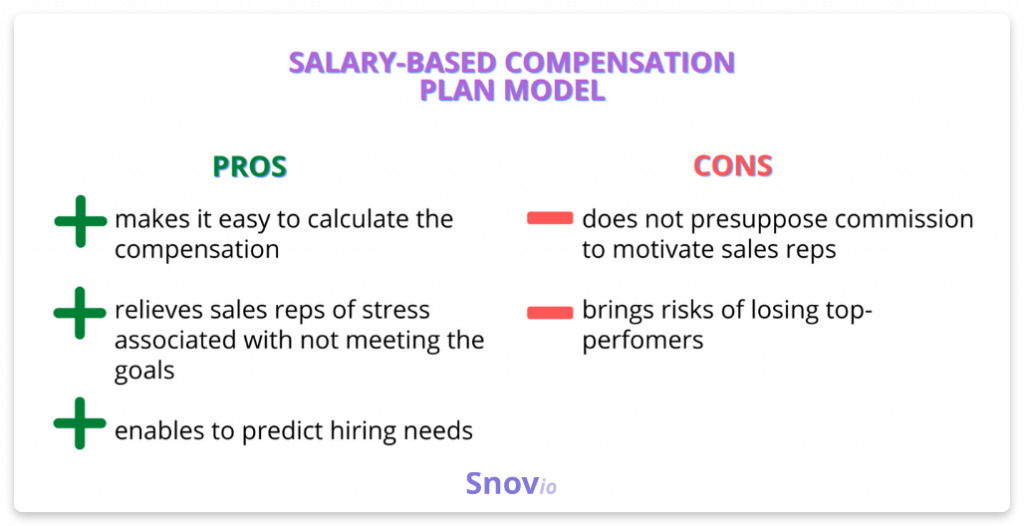
2. Commission-based compensation model
A commission-only plan presupposes paying sales reps based on their performance only. So, if they don’t close a deal, they get a zero. This model isn’t risky since the company pays per closed deals only. It also motivates sales representatives to work harder and get more money.
On the other hand, this sales-compensation plan makes it difficult to foresee your expenses and plan your budget correspondingly.
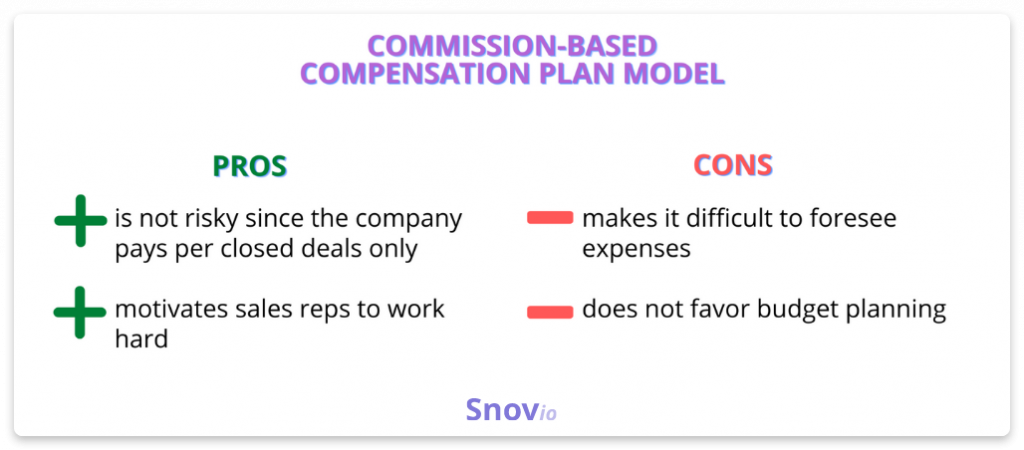
3. Salary+commission-based compensation model
This is the most common plan that allows sales reps to get a fixed income and stimulates them to sell. Besides, this model is beneficial for a company, which can budget the base salary and employ a motivated competitive sales team.
As a rule, the percentage of commission in this plan is lower because of the fixed salary. The pay mix (the ratio of fixed pay to variable pay) usually depends on the industry and sales roles.
There can be:
- More aggressive ratio: roles with more influence on purchasing decisions.
- Mid aggressive ratio: managers with wider sets of responsibilities.
- Less aggressive ratio: reps with longer sales cycles and strategic or consultative roles.
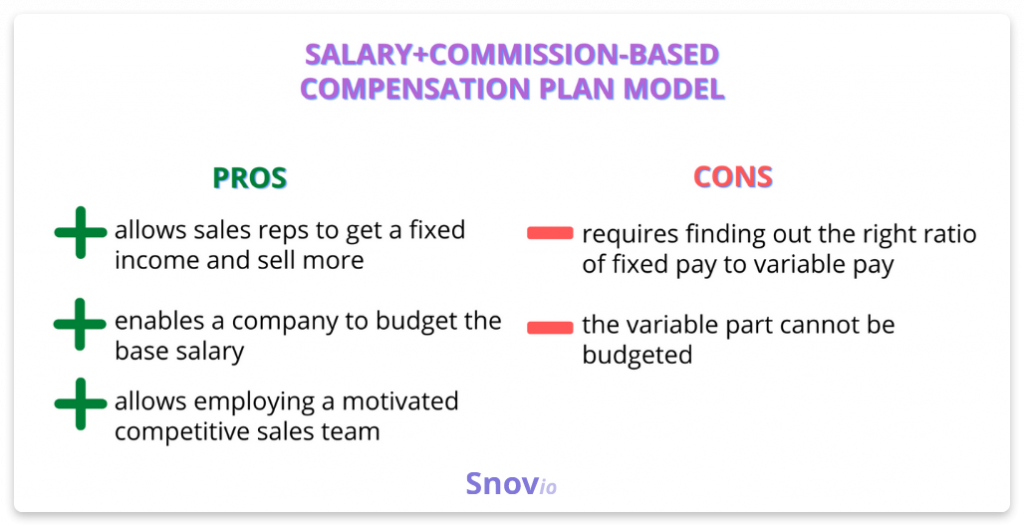
4. Salary+bonus compensation model
This plan can be used if you know that your sales reps tend to meet the pre-set goals. You may foresee your expenses by paying your salespeople a base amount and a predictable bonus per the particular number of sales.
For instance, if you know that 3 out of 5 sales representatives always hit quota and get $40,000, you may annually budget $120,000 for bonuses. Nevertheless, this model still makes it hard to motivate your salespeople to overperform.
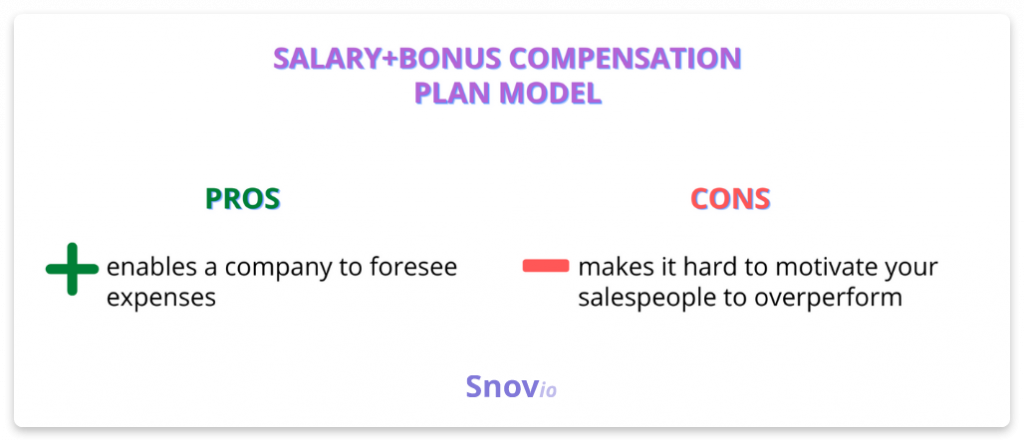
5. Straight-line commission model
This sales compensation plan presupposes rewarding salespeople based on how much or little they sell. For example, if a total commission is $1,000 and a sales rep reaches 90% of their quota, they get 90% of the commission, which is $900.
Being quite easy to calculate, this model may be not motivating enough. Say, if a person is okay with 80% of the quota, they will not be driven for selling more.
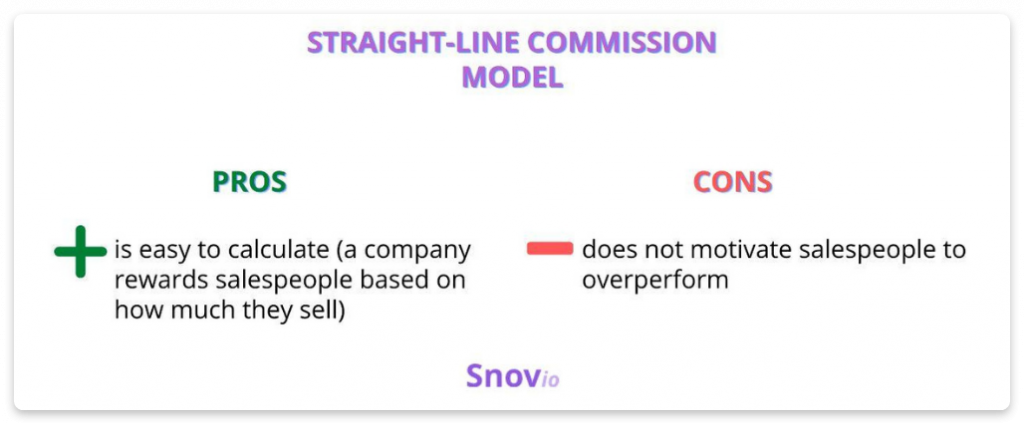
How to create a sales compensation plan
To ensure you have a right sales-compensation plan at hand, you should take the following steps:
Set your sales compensation plan objectives
Determining your goals is a key step for any strategy. Setting your sales compensation plan priorities will help you decide how to reward your salespeople in a way that works best for your company. Consider some examples of objectives you may set for your sales compensation plan:
- Grow revenue
- Increase the percentage of repeat customers
- Increase the customer lifetime value
- Lower expenses
- Boost sales for specific products, and so on
Determine your sales compensation model
Now that you have defined your goals, you should choose the type of compensation plan you will use for your sales team, which will depend on:
- The type of your company and its product
- Your sales cycle
- Your budget
- Your sales team size
- Analysis of sales compensation plans your competitors use
- Your salespeople’s expectations
Choose when and how you will provide compensation
If your plan presupposes a commission, determine when your salespeople will get compensated: when a customer signs a contract, when they send you their first payment, or every time a customer pays. Besides, you should choose a payroll software option to carry out your sales compensation plan.
Set quotas
Determine what you expect of your sales reps so that they will know how they can earn compensation. Remember that quotas must be reasonable, feasible, and yet reflecting the business goals.
As it is, only 24.3% of salespeople exceed their quota, which means the number of top performers is usually lower than the rest of your sales team. Thus, it’s advisable to target average performers while setting quotas to drive their movement several points upwards.
Review your sales compensation plan
Any business strategy can’t be actionable forever. The same goes for your sales compensation plan. As your sales team grows, and company objectives become more ambitious, it should undergo corresponding changes. However, remember that these changes must always be aligned with your sales reps’ expectations: they should feel motivated and rewarded.

Wrapping up
Sales compensation is an important factor in motivating your sales team. This is why choosing a sales compensation model that would be both targeted to your sales reps’ expectations and aligned with your company’s goals is a number one priority if you are pursuing sales growth. What your business will need to do next is to review its plan as long as you change your sales goals or direction.















